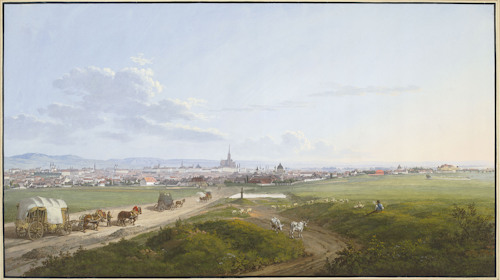
Any look at 19th-century Vienna inevitably brings up a particular family name. Jakob, Franz and Rudolf Alt seem to chart the life and landscape of the city in paint and printed graphics. An exhibition at the Albertina documents their skill and artistic importance.
- Highlights the work of these master watercolourists
- Gorgeous landscapes, cityscapes, and street views
- Focus on Rudolf von Alt
- Pictorial insight into historical Vienna, too
- Wall summaries and painting labels also in English
- Runs Nov 9, 2022 – Jan 29, 2023 (extended to Feb 5)
- See also:
- Albertina overview & info
- Current art exhibitions in Vienna
Jakob, Franz and Rudolf

(Jakob Alt, View of Vienna from the ‘Spinner at the Cross’, 1817; watercolor, body color; courtesy of and © the Albertina Museum, Vienna)
When Jakob Alt (1789 – 1872) arrived in Vienna from Frankfurt in 1810, he began a painting legacy that continued with his sons Rudolf (1812 – 1905) and Franz (1821 – 1914).
The three of them might be considered documenters of a time and place. Their work captured landscapes, people, and scenes from around Europe, and, perhaps most importantly, the life and form of 19th-century Austria and Vienna.
An exhibition at the Albertina brings their craft to the fore, drawing on the museum’s own vast collection of Alt paintings to do so.
I use the word documenters deliberately because many of the works by the Alts were formal commissions from state organisations, publishers, and the aristocracy.

(The Albertina over 200 years ago; Jakob Alt, Das Palais Herzog Alberts auf der Augustinerbastei, 1816; Feder in Schwarz, Aquarell; courtesy of and © the Albertina Museum, Vienna)
Jakob Alt, for example, produced 55 paintings of the Danube area for a lithographic publication, and his originals formed part of a major exhibition at the National Library in 2021.
The widely-travelled and much-in demand Jakob and Rudolf (later Rudolf von Alt) also produced dozens of paintings for Archduke (and later Emperor) Ferdinand, documenting the most beautiful parts of the monarchy and surrounds: the so-called peep box project.
All the Alts were particularly skilled in watercolours, successful pliers of their trade, and masters of their art: not journeymen but artists. So much so that some works leave you exasperated and confused as to how such detail and accuracy is even possible.
We discover, for example, how Rudolf Alt’s technique blossomed and surpassed that of his father’s. The majority of the galleries focus on his artistic development.
Rudolf eventually became a member and honorary president of the famous Klimt-led Secession artists group formed in 1897. His paintings appeared in the Secession’s first exhibition in March 1898 alongside works by Auguste Rodin, John Sargent, Max Klinger, Klimt himself, and others.

(The painter Rudolf von Alt (1812-1902) around 1862; Ferdinand Küss (Photographer); Wien Museum Inv.-Nr. 33483; excerpt reproduced with permission under the terms of the CC0 licence)
As well as allowing an exploration of the skill of watercolour painting, many of the pictures in the exhibition take you back to historical Italy, the Crimea, Dalamatia, and other parts of Europe.
In particular, we see Vienna before and during the great expansion that took place post-1855.
So you might catch a view of the Theater am Kärntnertor, long since demolished, where Beethoven’s Ninth Symphony enjoyed its world premiere. Or the State Opera House when the road before it echoed only to carriage wheels. Or the insides of Palais Harrach in the mid-1800s.
The preserved pictures of a time and place allow you to wallow in an almost wistful nostalgia, especially if you know the equivalent modern views.
Streets uncluttered by road signs and infrastructure. Or suburban countryside idylls where housing blocks now stand.
In the Spinner at the Cross painting featured at the top of this page, for example, the multi-lane congested Triester Straße of 21st-century Vienna is just a rutted lane flanked by open fields.
Though not every view is different: an 1831 painting of Josefsplatz looks almost identical to today’s square.
Dates, tickets and tips
Enjoy the Alt family oeuvre from November 9th, 2022 to February 5th, 2023. A ticket for the Albertina includes this exhibition.
For a current look at the same kind of scenes and buildings featured in much of the Alts’ work, see the location tips in this overview of the Biedermeier era. Look particularly to the Vienna Furniture Museum for interior décor (including complete rooms reconstructed in Biedermeier style).
To pay direct homage to the Alts, travel out to the Zentralfriedhof (Vienna’s main cemetery) where all three lie in honorary graves:
- Jakob and Franz occupy a family grave at Group 18 Row 2 Grave 66
- Rudolf von Alt has his own grave at Group 14A Grave 52.
How to get there
Scroll to the end of the main Albertina article for tips. But the museum lies very centrally just behind the state opera house and a short walk from the Hofburg complex.
Once inside, go on up to the second floor for the Alt exhibition.
Address: Albertinaplatz 1, 1010 Vienna